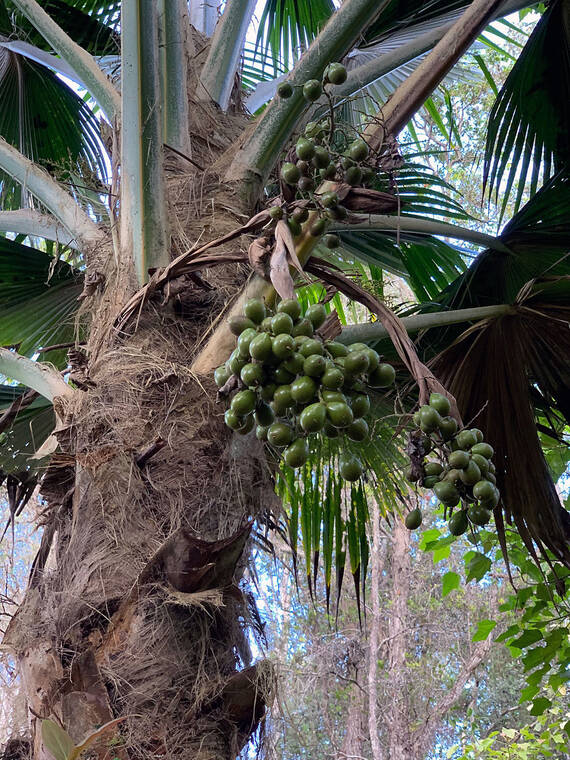The COVID-19 pandemic has clearly made us aware of how our individual lives and even society can be altered in a very short time by disease organisms. Our forests and landscapes can change rapidly as well. A very warm, wet period or a dry one can drastically alter the species makeup of a forest. For example, our ohia forests are suffering not only from Rapid Ohia Death, but from other diseases as well.
Warming weather has created ideal conditions for myrtle rust (Austropuccinia psidii) to cause defoliation, dieback and even death of ohia and many other related species in the myrtle family. Most rose apple trees have died out over the last decade due to this disease. Around 150 species are susceptible including mountain apple, guava, eucalyptus, callistemon, melaleuca and rhododendron. What happens as these species die? The answer is that other species fill the void thus altering forests and even our gardens.
Our Hawaiian gardens represent the continuing influence of many diverse cultures creating new experiences. The earliest gardens were composed of plants Polynesians brought with them from Asia, the vast Pacific and even South America. It is theorized that the first people may have come from Africa to Taiwan and between, thousands of years ago. This mix of ethnicities and plants they brought with them is extremely complicated and continues to this day as we share our islands.
What was it like for the first Polynesian pioneers who found these islands? The forests in those earliest days of human activity were very different than when Captain Cook arrived. What is now open grasslands used to be forests. Trees like loulu palms flourished in abundance, but it wasn’t long afterward that the Polynesian introduction of pigs and rats radically changed things.
There still remain at least 24 species endemic to Hawaii but for all we know there could have been scores more. All remaining species are threatened with extinction unless we intervene by planting them in our gardens and parks. With the later arrival of herbivores like goats, sheep, deer and cattle, even more damage was done to the forests. The State of Hawaii is concerned about the large deer population and has developed plans to reduce the population, but pigs do even more damage by spreading ROD fungus and creating conditions for invasive plant species and mosquitoes to proliferate.
Destruction, rebirth and evolution continue to happen as is taught to us by our active volcanoes and climate change. The moral is that we must learn to adapt to change and at the same time keep as many of the good qualities of the past where we can.
Our parks and gardens reflect this complicated evolution of life and culture. We have a wide variety of plants both native and introduced by many different ethnicities. By keeping the lush vegetation an integral part of our communities, we actually do our part to fight pollution, global warming and make life more enjoyable. As individuals, one of the easiest ways to decrease the carbon dioxide levels in the atmosphere is to plant trees. There are a number of trees that can help accomplish this purpose. Among the best are natives like the loulu palms, ohia, hala, wiliwili, hoawa, alahe‘e and a‘ali‘i. Other plants, such as the beach and mountain naupaka, are attractive to many birds and also make good ornamentals for a garden. Flowers of the ohia, koa, hau, milo and mamane may even attract some native nectar feeding birds like i‘iwi, amakihi, apapane, and elepaio.
The puhala, Pandanus odoratissimus, is found naturally growing along many coastal areas. The mountain ie‘ie‘, Frecynetia Arnotti, is found climbing vine-like up ohia trees in mauka forests, sometimes 80 feet or more.
Another group of plants to consider are those the Polynesians brought with them like coconut, kukui, mountain apple, banana, sugarcane, bamboo and breadfruit. These include hundreds of varieties and are referred to as canoe plants.
Remember that our gardens can and should reflect the best of the Hawaiian culture. At the same time recognizing that the Polynesian migrations around the Pacific evolved as time and the environment demanded. Thus Maori, Samoan, Tongan, Marquesan, Tahitian, South Asian and maybe even South American influences are also part of the ongoing cultural evolution and have a prominent place in our gardens. Hawaiian forests and gardens will no doubt be very different in years to come depending on what impact pests and people have on our islands and how we manage them.






